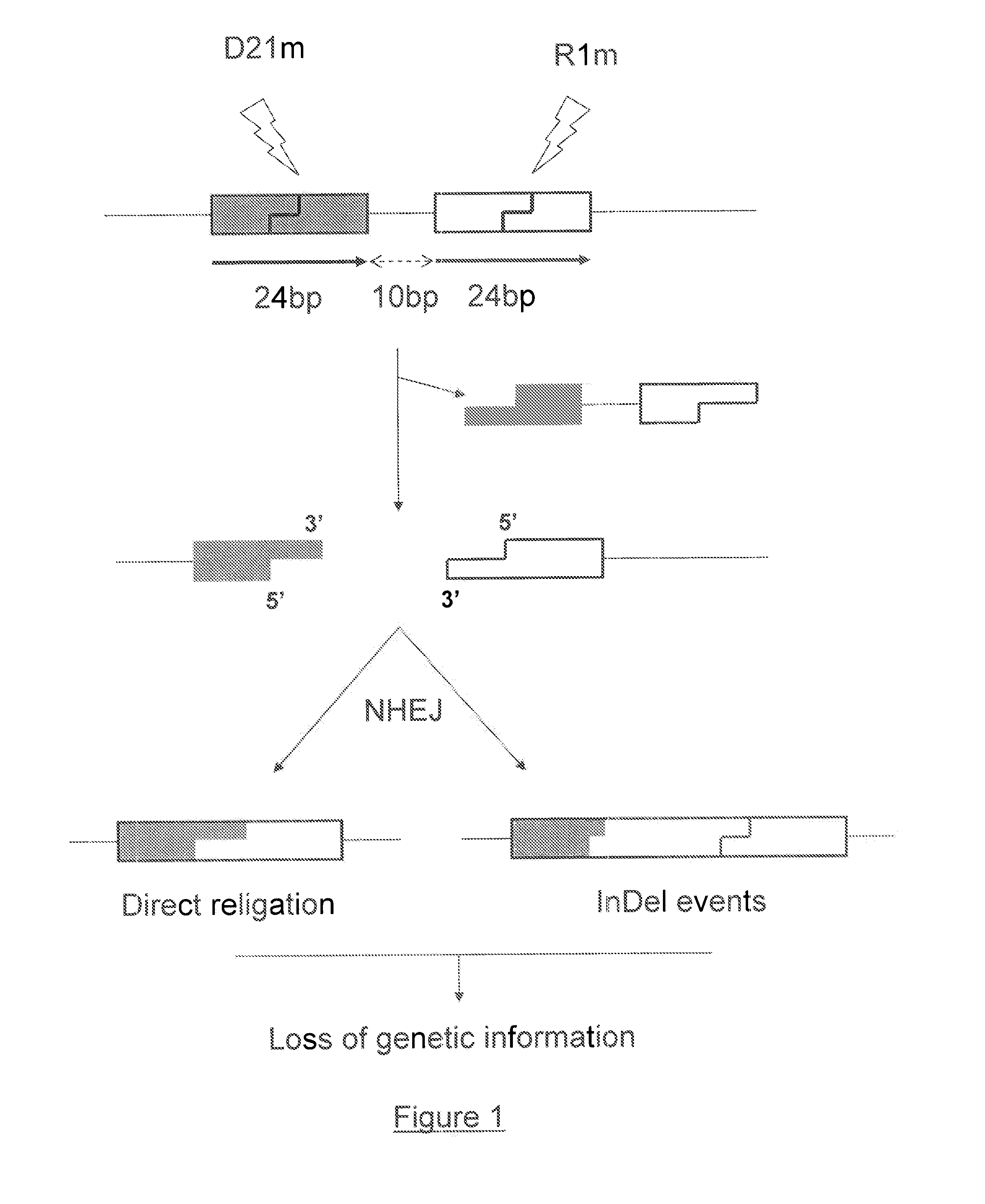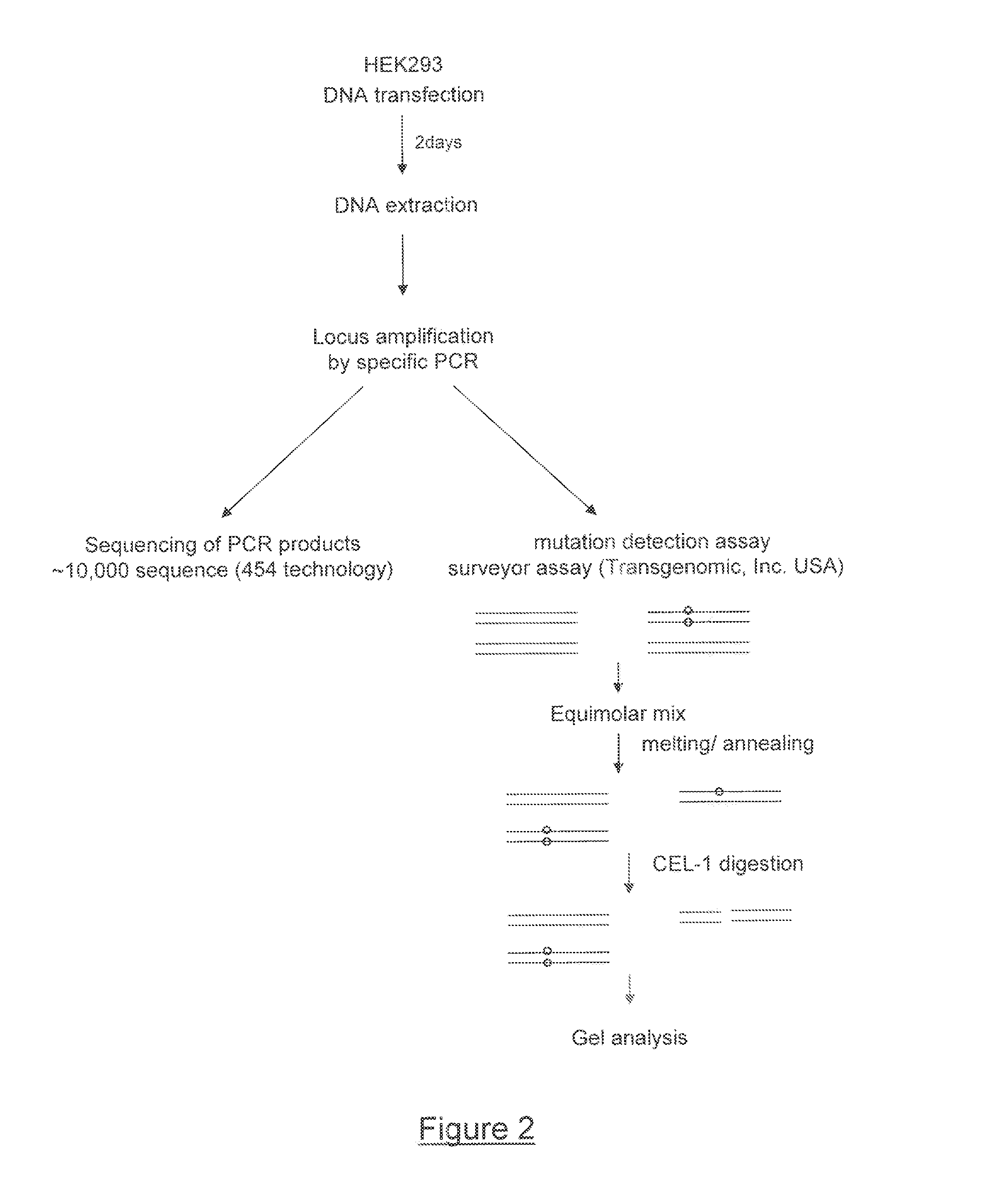Method for increasing the efficiency of double-strand break-induced mutagenesis
a double-strand break and mutagenesis technology, applied in the field of increasing double-strand break-induced mutagenesis at a genomic locus of interest, can solve the problems of low overall yield of induced mutations using these classical strategies, cell cycle arrest, cell death, etc., and achieve the effect of preventing any scarless re-ligation, and increasing double-strand break-induced mutagenesis
- Summary
- Abstract
- Description
- Claims
- Application Information
AI Technical Summary
Benefits of technology
Problems solved by technology
Method used
Image
Examples
example 1
[0208]Two engineered single-chain meganucleases called R1 or R1m (SEQ ID NO: 58) and D21 or D21m (SEQ ID NO: 59) are produced using the methods disclosed in International PCT Applications WO2003078619, WO2004 / 067736, WO2006 / 097784, WO2006 / 097853, WO2007 / 060495, WO 2007 / 049156, WO 2006 / 097854, WO2007 / 034262, WO 2007 / 049095, WO2007 / 057781 and WO2009095793 (Cellectis) and in (Chames, Epinat et al. 2005; Arnould, Chames et al. 2006; Smith, Grizot et al. 2006). These meganucleases, derived from I-CreI, are designed to recognize two different DNA sequences, neither of which are recognized by wild-type I-CreI. (recognition sequences, respectively, tgttctcaggtacctcagccag SEQ ID NO: 3 and aaacctcaagtaccaaatgtaa SEQ ID NO: 4). Expression of these two meganucleases is driven by a CMV promoter and a polyA signal sequence. The two corresponding recognition sites are cloned in close proximity to generate the target plasmid. For this example, the recognition sites are separated by 10 bp (FIG. 1). ...
example 2
[0211]In this example, an engineered single-chain meganuclease derived from I-CreI (described in International PCT Applications WO2003078619, WO 2004 / 067736, WO 2006 / 097784, WO 2006 / 097853, WO 2007 / 060495, WO 2007 / 049156, WO 2006 / 097854, WO 2007 / 034262, WO 2007 / 049095, WO 2007 / 057781, WO 2008 / 010093 and WO2009095793 (Cellectis) and in (Chames, Epinat et al. 2005; Arnould, Chames et al. 2006; Smith, Grizot et al. 2006)) is fused to various nuclease domains to create a bi-functional meganuclease. To obtain maximal activity, 31 different linkers are tested ranging in size from 3 to 26 amino acids (Table 1). Fusions are made using 18 different catalytic domains (Table 2) that are chosen based on their having essentially non-specific nuclease activity. Altogether, a library of 1116 different constructs are created via fusion to the N- or C-terminus of the engineered single-chain I-CreI-derived meganuclease, generating a collection of potential bi-functional meganucleases. Expression of t...
example 3
[0214]I-CreI meganuclease (SEQ ID NO: 76) was chosen as the parent scaffold on which to fuse the catalytic domain of I-TevI (SEQ ID NO: 60). Wild-type I-TevI functions as a monomeric cleavase of the GIY-YIG family to generate a staggered double-strand break in its target DNA. Guided by biochemical and structural data, variable length constructs were designed from the N-terminal region of I-TevI that encompass the entire catalytic domain and deletion-intolerant region of its linker (SEQ ID NOs: 61 to 66). In all but one case, fragments were fused to the N-terminus of I-CreI with an intervening 5-residue polypeptide linker (-QGPSG-=SEQ ID NO: 67). The linker-less fusion construct naturally contained residues (-LGPDGRKA-=SEQ ID NO: 68) similar to those in the artificial linker. As I-CreI is a homodimer, all fusion constructs contain three catalytic centers (FIG. 4D): the natural I-CreI active site at the interface of the dimer and one I-TevI active site per monomer.
[0215]The activity o...
PUM
| Property | Measurement | Unit |
|---|---|---|
| Volume | aaaaa | aaaaa |
| Volume | aaaaa | aaaaa |
| Volume | aaaaa | aaaaa |
Abstract
Description
Claims
Application Information
 Login to View More
Login to View More - R&D
- Intellectual Property
- Life Sciences
- Materials
- Tech Scout
- Unparalleled Data Quality
- Higher Quality Content
- 60% Fewer Hallucinations
Browse by: Latest US Patents, China's latest patents, Technical Efficacy Thesaurus, Application Domain, Technology Topic, Popular Technical Reports.
© 2025 PatSnap. All rights reserved.Legal|Privacy policy|Modern Slavery Act Transparency Statement|Sitemap|About US| Contact US: help@patsnap.com



